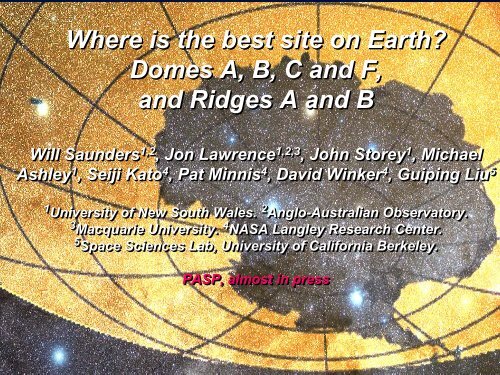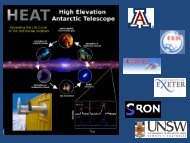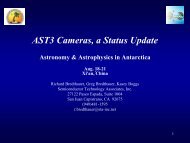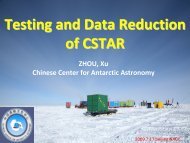Dome C
Dome C
Dome C
You also want an ePaper? Increase the reach of your titles
YUMPU automatically turns print PDFs into web optimized ePapers that Google loves.
Where is the best site on Earth?<br />
<strong>Dome</strong>s A, B, C and F,<br />
and Ridges A and B<br />
Will Saunders 1,2 , Jon Lawrence 1,2,3 , John Storey 1 , Michael<br />
Ashley 1 , Seiji Kato 4 , Pat Minnis 4 , David Winker 4 , Guiping Liu 5<br />
1 University of New South Wales. 2 Anglo-Australian Australian Observatory.<br />
3 Macquarie University. 4 NASA Langley Research Center.<br />
5 Space Sciences Lab, University of California Berkeley.<br />
PASP, almost in press
Site comparison includes<br />
Boundary layer thickness<br />
Cloud cover<br />
Auroral emission<br />
Airglow<br />
Atmospheric thermal backgrounds<br />
Precipitable water vapour (PWV)<br />
Telescope thermal backgrounds<br />
Free atmospheric seeing<br />
Doesn't include<br />
Non-winter use<br />
Sky coverage<br />
Dark time<br />
Infrastructure<br />
Non-astronomical uses<br />
F<br />
A<br />
C<br />
B
•F<br />
•A<br />
•G<br />
B<br />
•C<br />
Site Latitude Longitude Elevation Λ(2010)<br />
<strong>Dome</strong> A 80.37S 77.53E 4083m -84.9°<br />
<strong>Dome</strong> C 75.06S 123.23E 3233m -84.1°<br />
<strong>Dome</strong> F 77.19S 39.42E 3810m -77.0°<br />
Ridge B 76-79°S 97-93°E 3700-3809m -85.4° -87.1°<br />
South Pole 90°S 0°E 2800m -80.0°
BOUNDARY LAYER<br />
Swain & Gallee 2006a, 2006b;<br />
van Lipzig 2004, Parish & Bromwich 2007<br />
• Thinnest along<br />
'katabatic ridge'<br />
<strong>Dome</strong> A – Ridge B<br />
• + <strong>Dome</strong> F, <strong>Dome</strong> C<br />
• <strong>Dome</strong> F is best<br />
• <strong>Dome</strong> A is not quite<br />
on katabatic ridge
CLOUD COVER<br />
Aqua/MODIS satellite data, validated against GLAS, also CALIPSO<br />
Spring<br />
Summer<br />
Autumn<br />
Winter<br />
• Best weather<br />
along <strong>Dome</strong> F –<br />
<strong>Dome</strong> A – Ridge<br />
B – <strong>Dome</strong> C<br />
• Best weather<br />
misses <strong>Dome</strong> A<br />
• <strong>Dome</strong> C has best<br />
weather?
AURORAE<br />
Dempsey et al 2005 results for <strong>Dome</strong> C incorrect<br />
Used Hardy 1991 models, + South Pole<br />
measurements from Dempsey et al 2005<br />
Site Λ (2010)<br />
South Pole -80°<br />
<strong>Dome</strong> A -84.9°<br />
<strong>Dome</strong> C -84.1°<br />
<strong>Dome</strong> F -77.0°<br />
Ridge B -85.4° -<br />
87.1°<br />
• <strong>Dome</strong> A, <strong>Dome</strong> C,<br />
Ridge B very similar<br />
• Not much dependence<br />
on solar activity level,<br />
but brightest at solar<br />
minimum<br />
• 20-30% increase at V,<br />
100% at B<br />
• <strong>Dome</strong> F much worse
AIRGLOW<br />
From models of Liu et al 2008<br />
OI + OH<br />
Validated only for |latitude| < 40°<br />
Not much dependence on local time<br />
OI<br />
OH<br />
• OI much worse ( x 5) than<br />
temperate sites<br />
• OH ~25% worse<br />
• Spring OH hole,<br />
only <strong>Dome</strong> C can use
FREE ATMOSPERIC SEEING<br />
• Data from NCAR/NCEP reanalysis, May-Aug, 1995 - 2008<br />
• Use standard relations to get<br />
C n<br />
2<br />
= 3.62 x 10 -5 (P g) -2/3 (1/θ dθ/dz |dV/dz| ) 4/3<br />
• Assume |dV/dz| ∝ V<br />
(i.e. profiles are self-similar)<br />
• Use Trinquet et al (2008)<br />
profile as template<br />
⇒ C n2 profile at all positions
-60°<br />
-75°<br />
Seeing<br />
FREE ATMOSPHERIC SEEING cont.<br />
• Best between SP and DA<br />
• <strong>Dome</strong> F very good<br />
• large factors (x10!) in 'coherence volume'<br />
• Predicts South Pole better than <strong>Dome</strong> C ?<br />
• Very crude model, can do better!<br />
Isoplanatic angle<br />
Site ε 0<br />
(") θ 0<br />
(") τ 0<br />
(ms)<br />
South Pole 0.19 5.43 18.8<br />
<strong>Dome</strong> A 0.22 5.57 16.0<br />
Ridge A 0.21 6.29 17.6<br />
<strong>Dome</strong> C 0.26 3.39 8.44<br />
<strong>Dome</strong> F 0.21 5.17 15.4<br />
Coherence time<br />
Ridge B 0.23 4.07 11.1
ATMOSPHERIC THERMAL EMISSION<br />
Temperature data from NCAR/NCEP reanalysis<br />
Colder site ⇒ wider K dark<br />
Coldest between South Pole and<br />
<strong>Dome</strong> A<br />
Only measurement of K dark<br />
is at SP<br />
Origin of K dark<br />
background unknown<br />
Factors of 1.5-2 in thermal IR<br />
background between sites<br />
(Lawrence 2004)<br />
10000<br />
1000<br />
100<br />
Sky Brightness (Jy.arcsec -2 )<br />
10<br />
1<br />
0.1<br />
0.01<br />
1E-3<br />
1E-4<br />
1E-5<br />
1E-6<br />
3 4 5 6 7 8 9 10 11 12 13 14 15<br />
W avelength (μm)
PRECIPITABLE WATER VAPOUR<br />
Prediction from Swain and Gallee 2006b<br />
Should have real data from MHS sensor<br />
on NOAA-18 satellite.<br />
• Factor of 2 variations<br />
• Best between South Pole<br />
and <strong>Dome</strong> A<br />
• <strong>Dome</strong> F almost as good<br />
• <strong>Dome</strong> C not so good
SURFACE TEMPERATURE<br />
Prediction from Swain and Gallee 2006b<br />
Measurement from MODIS on Aqua satellite<br />
Variations quite small (few °)<br />
<strong>Dome</strong> A 204.1<br />
<strong>Dome</strong> C 204.9<br />
<strong>Dome</strong> F 204.9<br />
Ridge B 203.6<br />
<strong>Dome</strong> B 206.9<br />
Ridge A 203.5
DOME A versus 'RIDGE A'<br />
• Boundary layer, weather, free atmospheric seeing, atmospheric<br />
thermal emission, PWV, surface temperature ALL favour a site<br />
nearer South Pole<br />
• Obvious candidate is at the end of 'Ridge A' at (81.5°S 73.5°E 4053m)<br />
•RA<br />
•DA
'SUMMARY TABLE'<br />
SP DA RB DC DF RA<br />
Cloud Cover × √ √√ √√√ √√ √√<br />
Boundary Layer × √ √√ √ √√√ √√<br />
Aurorae × √ √ √ ×× √<br />
Free seeing √√√ √√ √ √ √√√ √√√<br />
IR sky brightness/PWV √ √√√ √√ √ √√√ √√√<br />
Surface temperature × √√√ √√√ √√ √√ √√√
• The coldest surface temperatures are found along <strong>Dome</strong> F – <strong>Dome</strong> A – Ridge B<br />
– <strong>Dome</strong> C. But offset from topographic ridgeline.<br />
• The best winter weather is found along the same line, with same offset. <strong>Dome</strong> C<br />
may have the best weather.<br />
• Thinnest boundary layer is found at <strong>Dome</strong> F, <strong>Dome</strong> A, along Ridge B, and at<br />
<strong>Dome</strong> C, in that order. Again there is an offset from the topographic ridge.<br />
• Best expected free seeing, isoplanatic angle, coherence time is found between<br />
<strong>Dome</strong> A, <strong>Dome</strong> F and the South Pole.<br />
• The lowest wintertime atmospheric thermal emission, and the lowest<br />
precipitable water vapour, is also found between <strong>Dome</strong> A, <strong>Dome</strong> F and the<br />
South Pole.<br />
• <strong>Dome</strong>s A and C and Ridge B are all similar from an auroral point of view, with<br />
significant contribution to the optical sky brightness. <strong>Dome</strong> F is much worse.<br />
• Airglow is significantly brighter than for temperate sites, except possibly in the<br />
spring, when there is an 'OH hole'. <strong>Dome</strong> C is the only site able to use this<br />
opportunity.<br />
• <strong>Dome</strong> A is clearly the best existing site. ’Ridge A’ (~150km southwest of <strong>Dome</strong><br />
A ), is likely to be even better.<br />
• <strong>Dome</strong> F is a superb site, with the exception of auroral activity.<br />
• The peak of Ridge B is a very good site but without any unique advantages.<br />
• <strong>Dome</strong> C may be almost as good as any other site for 2.5m K<br />
use.






